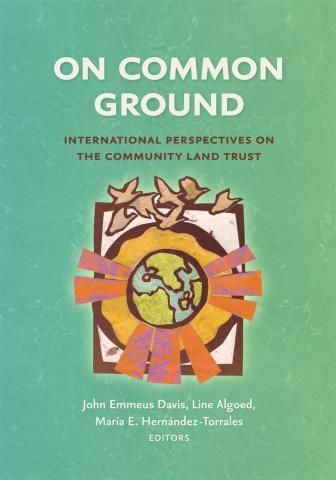
Around the world, the COVID-19 pandemic and its economic effects threaten to exacerbate already severe inequities, especially with regards to the ownership, access, and control of land and housing. In the United States, as eviction moratoriums in many states and localities come to an end and jobs remain scarce, experts are predicting a possibly unprecedented wave of displacement and homelessness. Against this bleak backdrop, a new book offers a ray of hope. On Common Ground, edited by John Emmeus Davis, Line Algoed, and María Hernández-Torrales, documents how interest in one of the more exciting new economic models to emerge in recent decades, the Community Land Trust (CLT), is spreading around the world.
In the US, modern CLT’s have their origin in the activities of the Civil Rights activists and Black organizers who formed the groundbreaking New Communities, Inc. settlement in rural Georgia in the late 1960s and early 1970s. At their core, CLTs involve democratically governed, community-based organizations (often non-profits) that manage and control land in order to ensure long-term affordability and access, and deliver material benefits to individual homeowners, businesses, and community groups. “A community land trust,” the editors explain, “is ownership for the common good, not ownership in common.” This innovative approach that straddles both individual and collective ownership strategies has allowed CLTs to gain significant traction in the United States (and other countries in the Global North), where historically a heavy emphasis placed on individual homeownership and market-based approaches to land and housing access have led to severe economic and racial disparities and inequities.
While surging interest in CLTs is both exciting and inspiring, it is critically important to begin investigating and analyzing the model beyond the context of the US and the Global North. On Common Ground is a masterful first step in this process. Bringing together 42 authors from 12 countries, the book artfully demonstrates not only how the CLT model is spreading around the world (with different characteristics based on local context), but also how it can intersect with the long and rich traditions many communities have with some of the ideas and conceptions that are central to the CLT approach (such as common ownership of land). “What unites a global community of CLT practitioners and scholars is more important than what separates us,” the editors write. “There is a shared commitment to reinventing and repurposing real estate for the common good. There is a shared conviction that community-owned land, in particular, is likely to do a better job of promoting equitable and sustainable development than land that is commodified and owned individually, especially in places populated by groups that have long been disadvantaged and disempowered.” The essays in On Common Ground demonstrate the power of this shared conviction.
In addition to providing an introduction to CLTs (and some of the important concepts behind them) and lifting up examples, updates, and context from around the world – including North America, Europe, Latin America, the Caribbean, Africa, Central America, and South Asia – On Common Ground includes an important section titled “Critical Perspectives: Meeting the challenges of a Changing Environment.” While undoubtedly all the entries in this section were written before the COVID-19 pandemic and mass uprisings against white supremacy, systemic racism, and police brutality swept the United States in the Spring and Summer of 2020, they are remarkably prescient and important.
For instance, in a chapter titled “The Burden of Patience in a Long March Toward Racial Justice,” Tony Pickett reminds readers that while CLTs had their origins in the Civil Rights Movement and the effort to secure land and economic (as well as political) rights for long oppressed Black residents, there is still considerable work that needs to be done to realize the potential of CLTs when it comes to racial and economic justice. Moreover, it is important that CLT practitioners and advocates recognize and address their own historic limitations on this front. “The first CLT was implemented by African-American organizers and leaders,” Pickett writes, “but the harsh reality is there hasn’t been a substantial increase in their numbers, visibility, influence, and power over the past 50 years of CLT expansion and evolution.” In addition to other critically important recommendations (including understanding and clearly defining what is meant by “community”), Pickett suggests that CLTs, and the CLT movement, cannot self-isolate and must play an active role in advancing a broader set of progressive policy ideas and goals. That they must, in essence, become part of a wider movement for systemic change in the United States, and the world.
The COVID-19 pandemic has illuminated and exacerbated stark racial and economic disparities and inequities in the United States and around the world, and has emphasized the desperate need for genuine international solidarity and cooperation amidst rising racism and xenophobia, a resurgence of right-wing populism, and a deepening distrust of democracy. Innovative models and approaches like CLTs offer both an alternative path to a more equitable and sustainable future and an antidote to the systems that are exacerbating our current crises. Filled with hope and promise, but grounded in real world experience and self-reflection, On Common Ground is a critically important book as we seek to build a more just and democratic future.